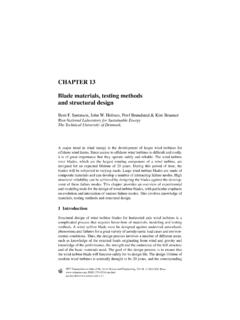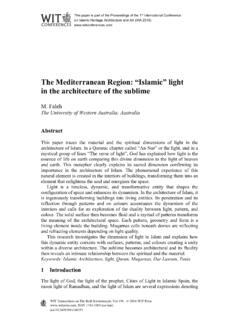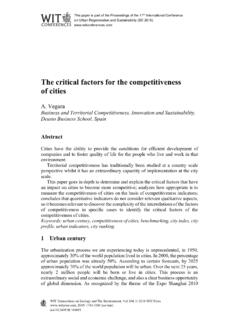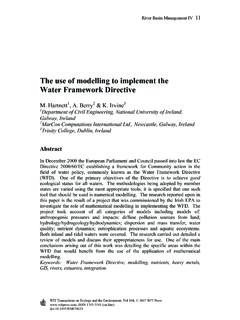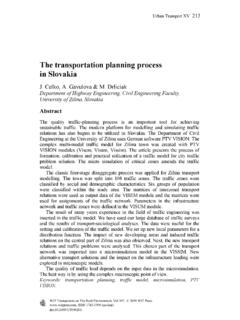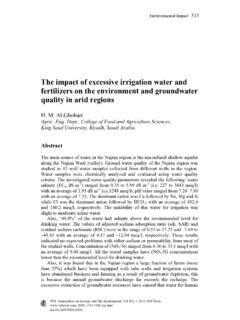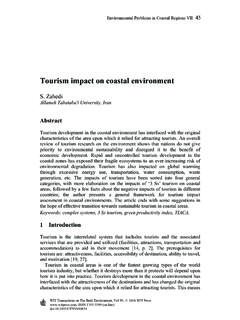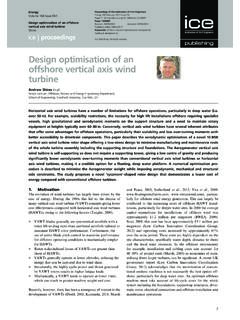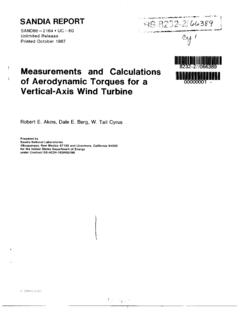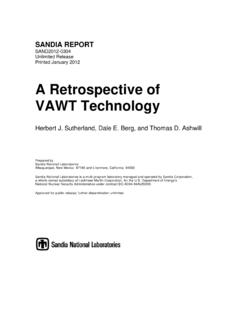Transcription of CHAPTER 8 Development and analysis of vertical …
1 CHAPTER 8 Development and analysis of vertical - axis wind turbines Paul Cooper School of Mechanical, Materials and Mechatronic Engineering, University of Wollongong, NSW, Australia. vertical - axis wind turbines (VAWTs) have been demonstrated to be effective devices for extracting useful energy from the wind . VAWTs have been used to generate mechanical and electrical energy at a range of scales, from small-scale domestic applications through to large-scale electricity production for utilities. This CHAPTER summarises the Development of the main types of VAWT, including the Savonius, Darrieus and Giromill designs. A summary of the multiple-streamtube analysis of VAWTs is also provided to illustrate how the complex aerodynamics of these devices may be analysed using relatively straightforward techniques. Results from a double-multiple-streamtube analysis are used to illustrate the details of the performance of VAWTs in terms of turbine blade loads and rotor power output as a function of fundamental parameters such as tip speed ratio.
2 The implications for VAWT design are discussed. 1 Introduction vertical - axis wind turbines (VAWTs) come in a wide and interesting variety of physical confi gurations and they involve a range of complex aerodynamic char-acteristics. Not only were VAWTs the fi rst wind turbines to be developed but they have also been built and operated at a scale matching some of the biggest wind turbines ever made. VAWTs in principle can attain coeffi cients of performance, C p ,max, that are comparable to those for horizontal- axis wind turbines (HAWTs) and they have several potentially signifi cant advantages over the HAWTs. These advantages include the fact that VAWTs are cross-fl ow devices and therefore accept wind from any direction. Thus, in principle, they do not need a yaw mechanism to ensure that they are aligned to the wind as is the case with all , ISSN 1755-8336 (on-line) WIT Transactions on State of the Art in Science and Engineering, Vol 44, 2010 WIT wind Power Generation and wind turbine Designhorizontal axis machines.
3 Another key advantage is that the mechanical load may be connected directly to the VAWT rotor shaft and located at ground level. This removes the need for a substantial tower to support the weight of equipment such as the gearbox, generator and yaw mechanism. There is also no need for slip rings or fl exible cables to connect the generator to the load, which can be an important point for small-scale turbines. From the 1970s to the 1990s a number of research groups and companies devel-oped and built hundreds of VAWTs and a great deal has been learnt from that experience. But despite the inherent advantages of VAWTs they have fallen sig-nifi cantly behind HAWTs in recent years in terms of technical Development and in the size and number of units manufactured. This has occurred for a number of reasons, not least because of some inherent disadvantages of VAWTs. As the VAWT blades rotate about the main rotor shaft the velocity of the air relative to the blade is constantly changing in respect of both magnitude and direc-tion.
4 In addition, each blade will interact with the wakes of other blades, and pos-sibly its own wake, when it passes through the downstream half of its path about the turbine axis . Both these effects result in fl uctuating aerodynamic forces on the blades, which in turn lead to a potentially signifi cant fatigue issue for the design of the blades and overall turbine structure. The fl uctuating blade loads also lead to a varying torque transferred to the mechanical load. Many designs of VAWTs produce very low torque when they are stationary and may produce negative torque at low tip speed ratios, so they must be powered up to a speed at which the aerodynamic torque is suffi cient to accelerate the rotor to nor-mal operational speeds. A further disadvantage is that parasitic drag losses may be high for a given VAWT design. This situation can arise when the VAWT blades need to be mounted on structures (spars, beams, cables, etc.)
5 That rotate with the blades or are located upstream of the blades. The drag forces on these passive components can lead to signifi cant parasitic losses in respect to rotor torque and power output. This has inhibited the successful Development of a number of VAWT designs. Nevertheless there continues to be widespread interest in VAWTs as a means of generating electrical and mechanical energy from the wind . Novel VAWT turbine designs appear relatively frequently at the time of writing and a number of small companies appear to be undertaking Development of VAWTs for small-scale application, particularly in respect to domestic dwellings. 2 H istorical Development of VAWTs Early VAWT designs VAWTs appear to have been developed long before their horizontal axis cousins. One of the reasons for this is that the VAWT has a number of inherent advantages including the fact that a drive shaft may be connected directly from the rotor to a mechanical load at ground level, eliminating the need for a gearbox.
6 The early pioneers involved in the Development of wind turbines many centuries ago applied VAWTs to the milling of grain, an application where the vertical axis of the mill-stone could be easily connected to the VAWT rotor. Quite a number of excellent , ISSN 1755-8336 (on-line) WIT Transactions on State of the Art in Science and Engineering, Vol 44, 2010 WIT PressDevelopment and analysis of vertical - axis wind Turbines 279review articles have been published in the past detailing the historical Development of wind turbines of all types [ 1 , 2 ]. Virtually all of these reviews suggest that the very earliest wind turbines were indeed VAWTs and it is thought that these were fi rst used in Persia for milling grain more than 2000 years ago. These early wind tur-bines were essentially drag devices with a rotor comprising a number of bundles of reeds, or other simple blades, on a timber framework. The rotor was housed within a walled enclosure that channelled the fl ow of wind preferentially to one side of the rotor thereby generating the torque necessary to rotate the millstone.
7 This type of device was still in use during the latter half of the 20th century and an example located in the border region of Afghanistan and Iran is shown in Fig. 1 [ 3 ]. The Persian and Sistan VAWTs had rigid vanes to generate torque whereas other designs have used sails that can effectively pitch with respect to their align-ment on the rotor and thus can potentially increase effi ciency. An example of a Chinese VAWT of the type used for many years for pumping applications, and which was described by King [ 4 ] for pumping brine for salt production, is illustrated in Fig. 2 . VAWT types A wide variety of VAWTs have been proposed over the past few decades and a number of excellent bibliographies on VAWTs have been published that sum-marise research and Development of these devices, including the survey by Abramovich [ 5 ]. Some of the more important types of rotor design are highlighted in the following sections.
8 Figure 1: An example of VAWTs in the Sistan Basin in the border region of Iran and Afghanistan. Note in the right hand image how the upstream wall is used to expose only one half of the rotor to the wind (photographs taken in 1971 near Herat, Afghanistan, copyright: Alan Cookson). , ISSN 1755-8336 (on-line) WIT Transactions on State of the Art in Science and Engineering, Vol 44, 2010 WIT Press280 wind Power Generation and wind turbine Design Savonius turbines The need to pump water in rural/remote locations has long been a driver for the Development of wind turbines. In the early 20th century a number of innovations were developed by inventors such as Savonius who patented his device in 1929 [ 6 ]. This utilised a rotor made from two half-cylinders held by a disc at each end of the rotor shaft, as shown in Fig. 3 . The Savonius turbine has been popular with both professional and amateur wind turbine developers over the years, not least because of its simple and robust construction.
9 Many variations of the Savonius rotor have been developed and tested. How-ever, because of the inherently high solidity and hence high mass of the Savonius turbine it has not been used for large-scale electricity production. Nevertheless, it continues to fi nd favour in a number of areas of application, including building-integrated wind energy systems which are now attracting attention as building designers seek to reduce the ecological footprint of building structures and their operations. M ller et al. [ 3 ], for example, explore the potential of VAWTs installed on buildings. Figure 4 shows an example of this type of application where Savonius turbines are mounted on the natural ventilation stacks of the landmark Council House 2 (CH2) Building in Melbourne, Australia. The low tip speed of rotors such as the Savonius has a number of attractions, not least that they are likely to produce less aerodynamic noise, which is an important issue for turbines included as part of inhabited structures.
10 However, a number of considerable challenges remain to be overcome before building-integrated wind turbines can provide a cost-effective means of generating electricity. These include the fact that the urban environment is characterised by low wind speeds and high turbulence. Figure 2 : A Chinese VAWT used for pumping brine (photo taken in early 20th century) from King [ 4 ]. , ISSN 1755-8336 (on-line) WIT Transactions on State of the Art in Science and Engineering, Vol 44, 2010 WIT PressDevelopment and analysis of vertical - axis wind Turbines 281 The Savonius rotor is primarily a drag device with some inherent augmentation of the rotor performance available due to the air fl ow across each vane and mutual coupling of the two halves of the rotor. Like all drag machines it has a low operat-ing tip speed ratio. This makes it less suitable for electricity generation than devices with higher tip speeds, since a high shaft speed is generally preferred to minimise the step-up ratio requirement of the gearbox coupling a rotor to a conventional electrical generator.


